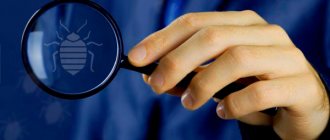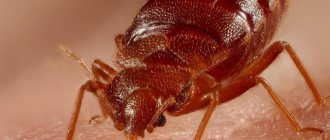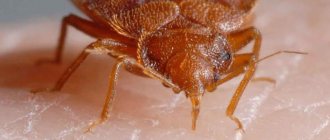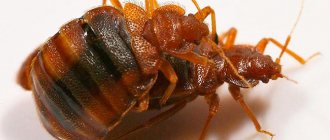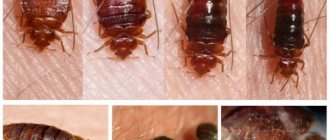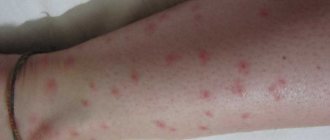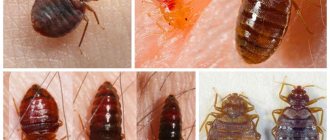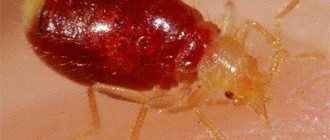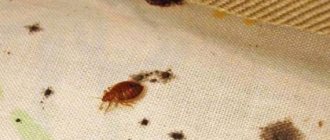In today's conditions, the likelihood of finding a bedbug in your apartment or private house is much lower than before. The reasons for this state of affairs are obvious - the successes of civilization both in terms of improving the sanitary and hygienic conditions of human life, and in terms of the emergence of new effective means of combating parasites.
At the same time, being around bedbugs can cause a lot of inconvenience. Therefore, it is extremely important to know what insects look like and to be able to detect them promptly and quickly. The article discusses the external signs of a bedbug, the differences between males and females, and the structural features of the insect’s body. Separate sections are devoted to a description of what the eggs and larvae of the parasite look like, as well as consideration of the differences between the bedbug and other representatives of this suborder of insects.
General information about the appearance of the insect
As noted above, bed bug (other commonly used names are apartment, linen, sofa, mattress, household, etc.)
is one of the types of bed bugs. It is widespread in different regions of the world, and its habitat coincides with that of humans. This is not surprising, given the peculiarities of the bedbug’s diet, which consists of human or animal blood.
The answer to the question of what an apartment bug looks like should begin by indicating the size of the insect. The length of the body of an adult varies widely - from 3 to 8-9 mm. As a rule, females are noticeably larger than males.
Depending on environmental conditions, quality and quantity of food, the color of the parasite varies from different shades of dull yellow to light and dark brown. The photo below shows a bedbug with a typical insect color.
What can a bedbug be confused with?
It would seem that a detailed description of the appearance of a bug makes it easy to distinguish it from any other insects, harmful or not. However, the variability in the appearance of the parasite, which allows for serious variation in both size and body color, often leads to confusion. For example, quite often a well-fed bug can be mistaken for a cockroach. Photos of both insects are posted below, with the bedbug on the left and the cockroach on the right.
The similarity between the two parasites is obvious. They have similar sizes, similar coloration of an elongated segmented body. The main differences lie in several parameters. Firstly, the bug's body looks more rounded. Secondly, it darkens only after feeding. Thirdly, cockroaches are much more mobile and fast than bed bugs, which move at a low speed even in a hungry state, and are generally inactive when well-fed.
Another parasite with which the bedbug is often confused is the linen louse. Confusion often arises when comparing insect larvae. Just look at the photo of a linen lice and compare it with the images above.
To combat different insect pests, various methods and means are used. Therefore, it is extremely important to know what a particular pest, including a bed bug, looks like, and to be able to distinguish them from each other. To do this, you should consider in detail the most important external signs of bedbugs at different stages of their life cycle.
PREVENTION OF BUGS
In some situations, the likelihood that bedbugs will soon appear in the apartment increases. It is in this case that all measures must be taken to prevent this from happening. This should be done immediately if:
- You have recently returned from vacation or a business trip. Even if you happen to live in a high-class hotel, and even more so in someone else’s apartment, be sure to process your belongings. If you did not find the insects themselves on your clothes, this does not mean that they could not lay their larvae there.
- If you decide to move, it is not recommended to immediately transport all your belongings to your new apartment. You should first carry out preventive treatment of the premises against harmful insects.
- If you have had guests in your home for one or more weeks, you need to take preventive measures after they leave.
- Alarm signal: there are bedbugs in your neighbors’ apartment. In this case, carry out the treatment especially carefully, because soon the insects may migrate to you.
What does a hungry and well-fed bug look like?
First of all, it is necessary to note the effect of food intake on the appearance of the bug. Perhaps no other insect living near a person changes its appearance so noticeably during feeding. An important feature of the parasite is its rapid saturation, for which the bug only needs 8-10 minutes.
The changes occurring in the appearance of the bug are obvious and are as follows:
- the body rapidly elongates and becomes oblong from almost round;
- the size of the insect increases significantly, it becomes more noticeable and inactive;
- the body color changes from translucent and yellowish or light brown to dark red and even burgundy. After a few minutes - after the blood has clotted - the color of the parasite may turn dark brown or almost black.
In the process of digesting food, the parasite’s body gradually “deflates”, decreases in size and takes on its usual shape. Therefore, it seems quite logical that it is much easier to detect and destroy a well-fed bug, large, bright and inactive. Moreover, after eating, the insect can spend several days in a shelter, where finding it is very problematic.
Ways to combat bedbugs
Bedbugs are slow, but very secretive. Females are very fertile and are able to quickly increase the population size. The fact that parasites are sedentary and try not to move away from the feeding site is successfully used by humans to destroy bedbugs.
In ancient times, beds and sofas were treated with steam. The linen was carefully ironed and washed in very hot water. This was done to destroy egg clutches, since embryos and larvae are very sensitive to overheating and die at a temperature of 50 degrees C.
Modern means of combating parasites are insecticides from the peritroid group:
- Executioner - destroys insects and their larvae, effective against eggs;
- Get - a representative of microencapsulated products, destroys all blood-sucking parasites and their larvae;
- Karbofos is a drug that has proven its effectiveness for decades and is used to combat bedbugs at all stages of their development;
- Raptor is a modern effective product against parasitic insects. Has no smell. The fast-acting substances in the product instantly block the activity of adult insects and young larvae, preventing a single bite.
There are other ways to treat an apartment against bedbugs, but the greatest effectiveness can be achieved with comprehensive measures and preventive measures.
It is unlikely that you will become infected with a dangerous disease from bedbugs; bedbugs do not carry AIDS or the plague, as they are sedentary and try not to leave the apartment. But bedbug bites cause severe allergies and itching, which interfere with a person’s normal life and rest, and sometimes lead to severe irritability.
How to distinguish a female bedbug from a male
In bed bugs, as in a significant part of other insects, females are somewhat larger than males. However, it is extremely difficult to distinguish them by this or some other characteristics. The fact is that deviations in size are in the vast majority of cases insignificant and amount to 1-2 mm. Much more serious differences in size, for example, between a young and an adult bedbug.
When answering questions about what a female bedbug looks like and how it differs from a male, a more rounded abdomen is often mentioned. But even this sign is very difficult to detect with the naked eye in practice, and it is not necessary. The fact is that both males and females of the parasite are subject to destruction. Moreover, gender, unlike food intake, does not in any way affect the danger or likelihood of detecting a bedbug.
What are bed bugs afraid of?
Bed bugs have always fed on blood, living next to humans, so over the centuries a colossal number of methods have been invented that promise to get rid of them, but in reality, not all of them turned out to be effective. What are the bugs that occupy bedding afraid of?
- Use a vacuum cleaner if you use it to collect parasites.
- Temperatures are above +45 degrees and below –17.
- High-quality insecticides.
- Deterrent properties of table vinegar.
- Sveta, even though it is not fatal for them.
You can learn more about the destruction of bed bugs from articles devoted to this topic separately.
Appearance of bedbug eggs and larvae
go through three stages of development in sequence before reaching adulthood The first is an egg, the second is a larva, the third is an imago (another name for a full-fledged adult individual capable of reproduction). The appearance of the last stage of development is described above. Here it is necessary to consider what the eggs and larvae of the insect look like.
What do bedbug eggs look like?
Bedbug eggs are small, translucent, elongated spheres with a characteristic white color. They are often mistaken for waste products or blood digested by insects. However, in reality the eggs look exactly as described above. To get an idea of the size, just look at the photo in which the eggs are shown together with an adult bug, having a body length of up to 8-9 mm.
It is important to note that this stage of parasite development is the most resistant to chemicals. Moreover, to completely destroy bedbugs and prevent their reappearance, it is necessary to eliminate all insect clutches.
What do small bugs look like?
Unlike some other insects, bed bugs do not develop pupae or nymphs. The larvae of the parasite look almost like an adult insect, differing only in their smaller size and slightly lighter color. The photo clearly demonstrates the changes that occur as the larvae mature and form a full-fledged bedbug capable of reproducing.
Even a quick glance at the image shows how the size of the bug’s body gradually increases while the color darkens. No other significant changes occur - neither in appearance, nor in the diet, nor in the lifestyle of the parasite.
The standard increase in the length of the larval body is 1 mm after each moult and meal. The diet of small bugs is approximately one meal every week or half a month. Thus, after a month and a half, the larva becomes an adult.
